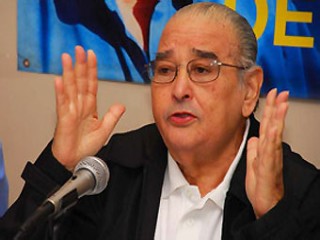
Guillermo Endara biography
Date of birth : 1936-05-12
Date of death : 2009-09-28
Birthplace : Panama
Nationality : Panamanian
Category : Politics
Last modified : 2011-05-27
Credited as : Politician, former President of Panama,
Guillermo Endara was a member of the Panamenista Party and an ally of Arnulfo Arias for many years prior to his installation as president of Panama by the U.S. Government in 1989.
Guillermo Endara was installed as president of Panama in the Christmas 1989 invasion (Operation Just Cause) by U.S. military forces sent to depose General Manuel Noriega. Until May 1989 Endara was virtually unknown to Americans. Then he became the presidential candidate of the Panamenista Party and the choice of Noriega's growing middle-class opposition, the Civil Democratic Opposition Alliance. Foreign dignitaries (among them former U.S. President Jimmy Carter) who monitored the May 7, 1989, election agreed that Endara won decisively. But Noriega ordered seizure of the ballot boxes and subsequently declared the election void and sent his goon squad (the Dignity Battalions) to harass the opposition, many of whom had taken to the streets in protest. Endara and vice-presidential candidate Guillermo Ford were both attacked. Endara celebrated his 53rd birthday in a hospital bed recovering from a beating with an iron bar, and his first wife, Marcela, with whom he had one daughter, died of a heart attack while he was bed-ridden. He had to await the U.S. invasion to be restored to the Panamanian executive office. He took the oath in the middle of the night of December 19-20 at a U.S. military base. On December 28, after Noriega had taken shelter within the Vatican embassy in Panama City, Endara wrote Pope John Paul II, pleading with him to have his ambassadors give Noriega over to the American invasion, since Endara could not guarantee Noriega a fair trial within Panama, which they did. Six months later Endara felt secure enough in office to marry Ann Mae Diaz Chen, a law student.
Guillermo Endara Gallimany was born on May 12, 1936, into a middle-class family. His parents were closely allied with Arnulfo Arias, founder of the nationalistic (and at one time anti-American) Panamenista movement in the late 1930s. When Arias was overthrown in a 1941 coup, the Endara family joined him in exile. During this time young Guillermo went to school in Argentina and a military school in Los Angeles, Calif. Returning to Panama, Endara attended the University of Panama Law School, graduating first in his class. He then attended New York University for further law studies until he returned to Panama in 1963, helping to found Solis, Endara, Delgado, and Guevara, now one of Panama's most successful law firms. He served two terms in the Panamanian National Assembly and taught law at the university. In 1968, when Arias returned to the presidency for the third time, Endara served as Arias' minister of planning and economic policy. When the Panamanian National Guard (which became the Panama Defense Forces in 1982) overthrew Arias in the October 1968 coup, Endara went underground, was jailed in 1971, and joined the deposed executive in exile until the ban on Arias was lifted.
In the 1980s Endara had a law practice in Panama City and continued to lecture at the University of Panama Law School. His political ties to Arias remained strong, however, and he supported Arias' continued opposition to the interference of the Panamanian military in national politics. By now the growing disenchantment of the U.S. Government (which, in the interest of national security and its efforts to wage a covert war against the government of Nicaragua, had tolerated Noriega's narcotics trafficking and arms dealing) made Arias and his cause more palatable. When Arias died in 1988, Endara took on the gargantuan task of leading the opposition to Noriega and the militarization of Panama. In the campaign of 1989 he promised to reinstitute democracy in Panamanian political life and remove Noriega from power. Seven months after the election the Christmas invasion restored the victory that Noriega's thugs denied him.
Endara and his two vice presidents—Guillermo Ford and Ricardo Arias Calderon—faced a difficult task. Six years of Noriega's rule had left much of Panama in poverty. In addition, a year after the invasion more than 2,000 people in Panama City were still homeless as a result of U.S. weaponry.
To call attention to these problems, Endara staged a public hunger strike from the steps of the Metropolitan Cathedral in Panama City. He visited then U.S. President George Bush, pressing for $1 billion in emergency relief aid and cooperative measures to curtail the Panamanian narcotics trade. The money, as it slowly came in, was applied to governmental expenditures, but where it was needed more was in a police force, since street crime and narcotics trade had skyrocketed since Noriega and his associates had been purged.
Despite this, the economy improved since Endara was able to convince foreign investors that Panamanian banks were once again safe depositories of their wealth. New construction and businesses thrived, and most businesses that existed before the invasion were once again active. Even the nearly 50 percent unemployment rate when Endara took office dropped by over 25 percent. Yet there was still criticism of the administration, since it tended to be populated by conservative, wealthy businessmen who had little connection with the poor. Endara's term as president ended in August, 1994. He was succeeded by Ernesto Perez Balladares.
















